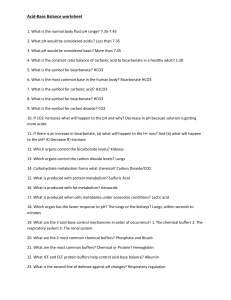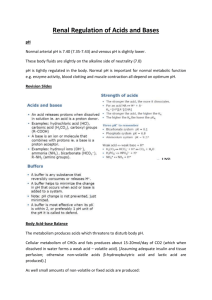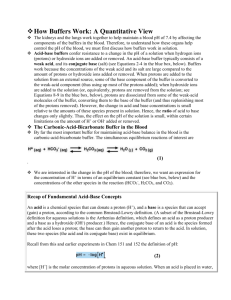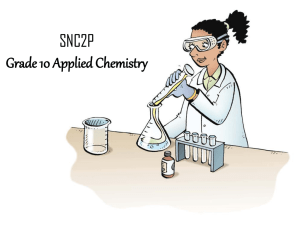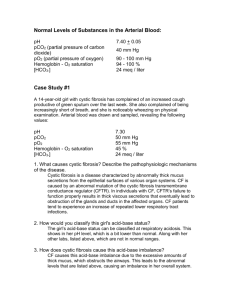Regulation of Acid-Base Balance During Exercise
advertisement
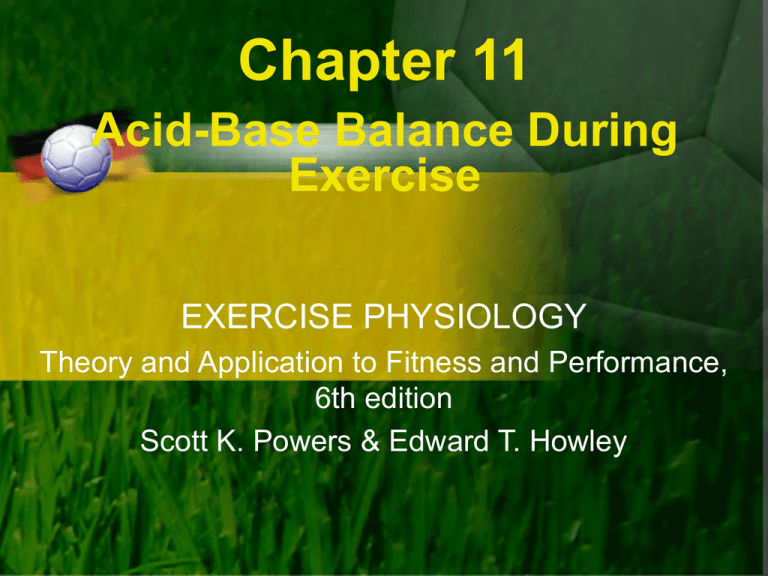
Chapter 11 Acid-Base Balance During Exercise EXERCISE PHYSIOLOGY Theory and Application to Fitness and Performance, 6th edition Scott K. Powers & Edward T. Howley Acids, Bases, and pH • Acid – Molecule that can liberate H+ ions • Raises H+ concentration – Lactic acid • Base – Molecule that is capable of combining with H+ ions • Lowers H+ concentration – Bicarbonate • pH – Measure of H+ ion concentration pH = -log10[H+] pH of Blood • Normal – pH = 7.4±0.05 • Acidosis – pH < 7.4 • Alkalosis – pH > 7.4 • Abnormal pH can disrupt normal body function and affect performance The pH Scale Figure 11.1 Acidosis and Alkalosis Figure 11.2 Sources of H+ Ions During Exercise • Volatile acids – Carbon dioxide CO2 + H2O H2CO3 H+ + HCO3- • Fixed acids – Sulfuric acid – Phosphoric acid • Organic acids – Lactic acid Sources of Hydrogen Ions Due to Metabolic Processes Figure 11.3 Sport and Muscle Acid-Base Balance Risk of Acid-Base Sport Disturbance Baseball Low Basketball Low-to-moderate Boxing Low-to-moderate Cross-country skiing Low Football (American) Low 100-meter sprint Low 100-meter swim Low 400-meter run High 800-meter run High 1,500-meter run Moderate-to-high 5,000-meter run Moderate 10,000-meter run Low-to-moderate Marathon run Low Soccer Low-to-moderate Weight lifting (low repetitions) Low Volleyball Low Importance of Acid-Base Regulation During Exercise • Failure to maintain acid-base balance may impair performance – Inhibit ATP production – Interfere with muscle contraction • Acid-base balance maintained by buffers – Release H+ ions when pH is high – Accept H+ ions when pH is low Acid-Base Buffer Systems • Intracellular – Proteins – Phosphate groups – Bicarbonate • Extracellular – Bicarbonate – Hemoglobin – Blood proteins • Bicarbonate buffering system CO2 + H2O H2CO3 H+ + HCO3- Acid-Base Buffer Systems Buffer System Bicarbonate system Constituents Sodium bicarbonate (NaHCO3) Carbonic acid (H2CO3) Actions Converts strong acid into weak acid Converts strong base into weak base Phosphate system Sodium phosphate (Na2HPO-4) Converts strong acid into weak acid Protein system COO- group of a molecule Accepts hydrogens in the presence of excess acid NH3 group of a molecule Accepts hydrogens in the presence of excess acid Table 11.2 Regulation of Acid-Base Balance • Lungs – When H+ concentration increases (low pH) • Increases ventilation • CO2 is “blown off” and pH increases • Kidneys – Regulate blood bicarbonate concentration – Important in long-term acid-base balance • Not significant in acid-base balance during exercise Regulation of Acid-Base Balance During Exercise • Lactic acid production depends on: – Exercise intensity – Amount of muscle mass involved – Duration of exercise • Blood pH – Declines with increasing intensity exercise • Muscle pH – Declines more dramatically than blood pH • Muscle has lower buffering capacity Changes in Arterial Blood and Muscle pH During Exercise Figure 11.4 Regulation of Acid-Base Balance During Exercise • Buffering of lactic acid in the muscle – 60% through intracellular proteins – 20–30% by muscle bicarbonate – 10–20% from intracellular phosphate groups • Buffering of lactic acid in the blood – Bicarbonate is major buffer • Increases in lactic acid accompanied by decreases in bicarbonate and blood pH – Hemoglobin and blood proteins play minor role Changes in Blood Lactic Acid, HCO3-, and pH During Exercise Figure 11.5 Regulation of Acid-Base Balance During Exercise • First line – Cellular buffers • Proteins, bicarbonate, and phosphate groups – Blood buffers • Bicarbonate, hemoglobin, and proteins • Second line – Respiratory compensation • Increased ventilation in response to increased H+ concentration Lines of Defense Against pH Change During Intense Exercise Figure 11.6
